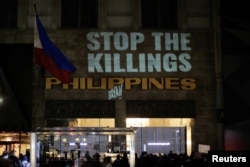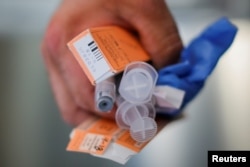Southeast Asian authorities are not shy about doling out the death penalty to punish drug traffickers, and yet narcotics abuse has not abated. If anything, it is on the rise, which begs the question of whether the region’s war on drugs is working.
The latest report on global trends from the United Nations shows that while Colombia remains the world’s top source of cocaine, Asia is now emerging as a hub for both transportation and consumption of the drug. In 2016 cocaine seizures tripled across the continent in the span of just a year, the U.N. Office on Drugs and Crime said in its June report.
But methamphetamine is making even bigger leaps in Southeast Asia because it is not as geographically restricted as cocaine, which depends on cultivation of the coca plant. Officials in countries around the Mekong region seized 65 tons of methamphetamine in tablet and crystalline form in 2017, the UNODC said in a separate report -- that is nearly 600 percent more than the amount seized a decade earlier.
The latest findings “show that drug markets are expanding, with cocaine and opium production hitting record highs, presenting multiple challenges on multiple fronts," said UNODC Executive Director Yury Fedotov.
Irony of drug policy
The apparent popularity of some drugs around the region stands in stark contrast to the “tough on crime” approach of many Southeast Asian governments, most of which have seen single ruling parties, military juntas, or authoritarian leaders consolidate power at the central level in recent decades.
In the Philippines, President Rodrigo Duterte has earned notoriety for alleged extrajudicial killings of drug crime suspects. In Vietnam, capital punishment is meted out, often to drug traffickers, more often than anywhere else on the planet except in China and Iran, Amnesty International says. The human rights group also referred to Malaysia as one of the “staunch supporters of the use of the death penalty for drug-related offenses.”
“Mandatory death sentences and the use of the death penalty for drug-related offenses remained an issue of high concern in Southeast Asia,” Amnesty International said in its roundup of state executions worldwide in 2017.
These trends might puzzle some who expect stiffer law enforcement to blunt the use and sale of drugs. But it is a tragic irony that legal crackdowns can actually fuel the narcotics trade, according to author Johann Hari. He writes in his book Chasing the Scream that when the police crack down on drugs, they drive up prices as buyers pay sellers a premium for the legal risk. Criminalization eliminates weaker rivals and allows the big players that are left standing -- usually gangs and cartels -- to corner the market and concentrate power, Hari said.
He is part of a growing chorus of people who question or outright reject the belief that the death penalty deters or reduces crimes like drug trafficking.
“The drug problem is a complex social issue that demands a multifaceted approach towards a lasting solution,” Nymia Pimentel-Simbulan, executive director of the Philippine Human Rights Information Center, told VOA. “PhilRights has always maintained that capital punishment, being punitive and retributive in nature, is a cure worse than the poison.”
Dark web
The UNODC offers other possible explanations for the spread of drugs in Southeast Asia and elsewhere. Buyers have new online options as it becomes easier to access the dark web, where hidden sites deal in contraband from weapons to counterfeit products to drugs. The anonymity of cryptocurrencies has facilitated these purchases on illicit sites. At one point in 2017 Vietnam was among the top three countries for bitcoin trading, though much of that had to do with investment and other legal business activity.
While the U.S. is grappling with an opioid epidemic, there could be spillover effects in other regions, and for similar reasons. One cause of the U.S. crisis was the labeling change that allowed certain opioids to be marketed as non-addictive because they didn’t take full effect immediately, but had a slow release. That allowed doctors to prescribe the painkillers more widely. In Asia the opioid of choice is tramadol. The UNODC said that not only are more people abusing tramadol here, but Asia is also the main source of illegal tramadol seized around the world.
As for methamphetamine, the agency said the ease of cooking rather than growing it could explain why the stimulant is taking off.
“This unique characteristic of synthetic drugs provides a comparative advantage for drug trafficking groups in the Mekong and neighboring countries,” the UNODC said, “as Asia is the center of global chemical and rapidly growing pharmaceutical industries.
There were 86 drug labs discovered in East and Southeast Asia in 2006; a decade later, the number surpassed 500, UNODC figures show. As with so much other data, it is unclear whether the abuse and sale of controlled substances are increasing -- or if authorities are just getting better at finding them.









